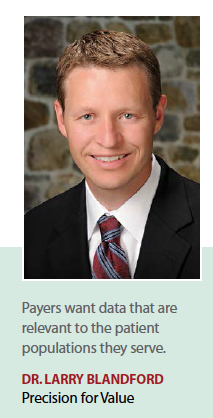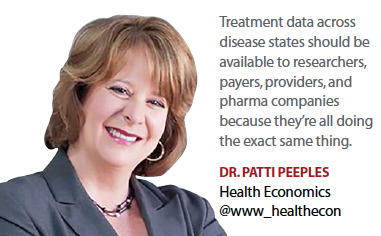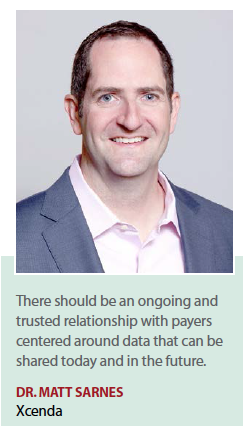 Value-assessment mechanisms, comparative effectiveness, and health economics and outcomes research are among several factors that are forcing the life-sciences industry to better illustrate the overall value of its products in an attempt to retain some power over insurance reimbursement decisions. As pharmaceutical and biotechnology companies prepare to enter tomorrow’s market, now more than ever, they will need to demonstrate a brand’s value to payers.
Value-assessment mechanisms, comparative effectiveness, and health economics and outcomes research are among several factors that are forcing the life-sciences industry to better illustrate the overall value of its products in an attempt to retain some power over insurance reimbursement decisions. As pharmaceutical and biotechnology companies prepare to enter tomorrow’s market, now more than ever, they will need to demonstrate a brand’s value to payers.
In Europe, assessment mechanisms have more of a stronghold than in the United States, but industry leaders see the writing on the healthcare decision-making wall — it won’t be long before these tools gain more traction here.
According to a recent study by Cutting Edge Information, health economics and outcomes research groups are currently far more impactful in Europe than in the United States. In several head-to-head comparisons, HEOR groups fared better at impacting the Institute for Quality and Efficiency in Health Care in Germany and the National Health Service in Great Britain than either Blue Cross Blue Shield or government payers — such as Medicare and Medicaid — in the United States.
In a recent Forbes op-ed, Eli Lilly CEO John Lechleiter said the creation of value-assessment algorithms is a booming cottage industry in the United States, and poses a threat to the quality of healthcare.
According to a report by the IMS Institute for Healthcare Informatics, patients in countries that use cost-per-quality-adjusted life-year measures have poorer access to new cancer drugs than patients in countries that don’t use those metrics.
Mr. Lechleiter reports in his column that this ultimately translates to patients receiving less effective treatments in countries that use these assessments.
To ensure patients continue to have access to the innovative drugs they need and companies can maintain their ability to manufacture new products, the industry needs to effectively communicate its value to payers, beyond pricing.
 For example, Novartis has presented data that demonstrate that fewer heart failure patients treated with its Entresto drug were readmitted to the hospital for heart failure or for any cause within 30 days of discharge (from a heart failure hospitalization), compared with patients treated with Enalapril. This suggests that these lower readmission rates correlate with improved patient prognosis and lower costs to the healthcare system.
For example, Novartis has presented data that demonstrate that fewer heart failure patients treated with its Entresto drug were readmitted to the hospital for heart failure or for any cause within 30 days of discharge (from a heart failure hospitalization), compared with patients treated with Enalapril. This suggests that these lower readmission rates correlate with improved patient prognosis and lower costs to the healthcare system.
Novartis’ positioning of Entresto in this way shows how the industry is starting to adapt to a value-based payer environment.
“Some pharmaceutical companies are really stepping into this pond in a big way," says Patti Peeples, Ph.D., CEO and founder of Health Economics.
“Novartis is one of the most recent manufacturers coming forth with its risk-sharing model based on clinical outcomes for Entresto. However, performance-based risk sharing has been going on since 1998, with Merck’s program for Zocor, but the practice hit a plateau because payers and pharmaceutical companies had difficulty agreeing on what outcomes need to be assessed."
However, in just the past year, the industry has witnessed a spike in value-based contracts, says Larry Blandford, Pharm.D., executive VP and managing partner, Precision for Value. Outcome-based contracts have emerged in the hepatitis C category, as well as a pay-for-performance deal between Harvard Pilgrim Health Care and Amgen for its new cholesterol drug Repatha. At the time, the deal was Repatha’s first pay-for-performance contract. Amgen has since entered into additional performance agreements.
Dr. Blandford also notes Novartis’ approach with Entresto as an example of the growing trend toward value-based positioning.
“We’re seeing more companies bringing these types of proposals forward at launch, because they’re realizing they need to bring more to the table supporting the value of their product to justify the price they are seeking," Dr. Blandford says. “If pharma companies are not bringing these types of innovative thoughts and value-based structures to payers as at least an option, they are behind the game, particularly in cases when other companies are offering them."
According to Susan Garfield, Dr.Ph., principal, EY, the clinician-driven decision model for determining the most appropriate care for patients has been eclipsed by a more structured payer evaluation.
“In the past 10 years, we’ve seen a really strong evolution in that payers now have a much more structured and rigorous way of evaluating new treatments through health technology assessment processes, considering both the clinical and cost impact of innovation and then creating some very strong structure within coverage policies to determine what is most appropriate," Dr. Garfield says.
 It isn’t just the payer market that has evolved, but the general healthcare landscape has shifted, especially in terms of precision medicine. The innovative therapies that are coming to market are creating an alignment around an outcome- or value-driven approach.
It isn’t just the payer market that has evolved, but the general healthcare landscape has shifted, especially in terms of precision medicine. The innovative therapies that are coming to market are creating an alignment around an outcome- or value-driven approach.
“As some really incredible gene- and cell-based therapies and innovative cardiac therapies come online, they are forcing the hands of payers and the industry to work together and be more innovative in how they approach payment and reimbursement," Dr. Garfield says. “I think all stakeholders in the healthcare ecosystem – payers, providers, delivery networks, health technology assessment groups, and government — have evolved their thinking."
One of the drivers behind the evolution is the advancement of high-cost, extremely effective targeted therapies that will be game changers for patients, but could break the bank, as well. According to Dr. Garfield, the payer system is not set up to manage an onslaught of costs, even if the innovations have a major clinical benefit. Value-driven, outcomes-based approaches will help absorb some of the innovative technologies coming to market. In the past, a 5% improvement over the standard of care was acceptable, but with big-ticket therapies headed down the pipeline, payers need a more structured way to review value and impact across products, therapeutic areas, and populations.
“People are really excited about an outcomes-driven model because historically most products that have come to market have provided an incremental or marginal benefit over the standard of care," she says. “But now we’re forced into a situation to ask is that enough? This seems to be the work that’s evolving in real time."
An outcomes-driven point of view takes the primary focus away from the product, and sheds more light on the health of the population and working together to create access for a system of care that improves outcomes.
“Today, the pharma industry is trying to figure out the best way to collaboratively work with payers and help them understand that their interests are aligned," Dr. Garfield says.
What Payers Want
Precision for Value conducted a 2015 Digital Trends study on the types of information managed care organizations requested and received from pharmaceutical companies. The study found that across all market segments, payers most frequently requested clinical data from pharmaceutical companies.
“Increasingly, payers want efficacy data, but they also need context regarding where that data places a drug in the treatment paradigm," Dr. Blandford says. “Payers also consider the total cost of care alongside the price of a particular drug. However, the challenges most payers have with integrating costs across the spectrum of benefits have led to interest in efficacy tied to either pharmacy costs only or to surrogate markers, such as lab results. Information from pharmaceutical companies that demonstrates those connections is highly valued by payers and more likely to be acted upon."
 According to the study, payers request specific information from pharmaceutical companies and they usually receive less than what they asked for.
According to the study, payers request specific information from pharmaceutical companies and they usually receive less than what they asked for.
However, payers typically receive more dossiers and patient education materials than they request.
“The study indicates that pharmaceutical companies have an opportunity to realign their information to raise their relevancy with payers," Dr. Blandford says. “Most importantly, payers want the data provided to be relevant to the patient populations they serve."
Experts on both sides acknowledge that sometimes payers want information that pharma can’t provide, either for regulatory reasons, or logistically the data are unavailable, or would be too expensive to compile for each insurer.
“Payers are asking the pharmaceutical industry to not only present them with cost-effectiveness information and incremental cost-effectiveness information that is comparing the new product to the most used alternative, but they also are asking the pharmaceutical industry to present these data based on more real-world patient populations," Dr. Peeples says. “Of course, it’s impossible for the pharmaceutical industry to have this information prior to launch and it is expensive and burdensome to gather it after launch, but this is an essential component for payers so they can understand how a new product fits into all of the different alternatives that they have to manage within the patient population."
To provide the data, account managers must know and understand each payer’s need.
“Account managers have had to raise their game," says Matt Sarnes, senior VP, commercial consulting, Xcenda, a part of
AmerisourceBergen. “Pharma companies have been aware of this emerging trend for a number of years and they’ve been training their account managers for the new age of account management."
Dr. Sarnes says account managers need to have the skills to have at least a basic conversation about health economics and they need to know their customers. It is vital that they understand what payers are really looking for in terms of quality metrics, what drives their business, and what data are relevant to that therapeutic area and how it all relates to how pharma companies can help them.
Dr. Peeples, who frequently moderates payer advisory boards, says she has observed three basic questions that get asked at every advisory board, regardless of the product or the device, and because of this, she suggests providing a level of data sharing across therapeutic categories that payers could easily access.
 “There is rarely an advisory board that I’m moderating that these same questions are not raised from the payer: what is the burden of this disease in a population segment; what are the treatment options in terms of efficacy and effectiveness, effectiveness being how the drug performs in the real world; and how can pharma help train providers to provide care that meets quality metrics?"
“There is rarely an advisory board that I’m moderating that these same questions are not raised from the payer: what is the burden of this disease in a population segment; what are the treatment options in terms of efficacy and effectiveness, effectiveness being how the drug performs in the real world; and how can pharma help train providers to provide care that meets quality metrics?"
Dr. Peeples recommends making the answers to these questions, along with epidemiology data, treatment guidelines, and treatment options available through pharma portals.
“This information across disease states should be available to researchers, payers, providers, pharma in general, because everyone is doing the exact same thing and the enormity of the money spent doing the same thing over and over is mind-boggling," she says.
The pricing of the product should be confidential between the payer and the pharma company, she adds, but the disease management, the treatment components, and estimates of adverse events should be freely available.
Finding Common Ground over Value
Relationships between payers and account managers could be the topic of a new self-help book: Payers are from Venus, Pharma is from Mars, because each party’s point of view comes from two diverging planets.
“The biggest issue is that pharma and payers are not speaking the same language," says Everett Neville, VP and chief trade relations officer, Express Scripts. “What payers want is what pharma thinks it is providing, but there is a lack of agreement on what is needed."
In Mr. Neville’s experience, the pharmaceutical industry does quite well in providing information to payers about its products, but the disagreement comes when the two parties try to assess the value of a drug. The two parties are often at extreme ends of the spectrum when trying to come to an agreement over how much payers will reimburse for a treatment.
One of the toughest hurdles between pharma companies and payers is coming to a common definition of value. Pharma has traditionally focused its value proposition on the patient, but now, it must also consider how payers will perceive the treatments value.
“Payers want products that bring an improvement to outcomes — whether by better cures, shorter terms of therapy, or fewer side effects — and are better than treatments available today, at a price that is commensurate with the drug’s value," Mr. Neville says.
As an example, he compares the value of two hepatitis C treatments, AbbVie’s Viekira Pak and Gilead’s Harvoni. Earlier this year, both companies were in the news for the high price of their treatments. Even though the drugs are effective in curing Hep C, the prices that the companies requested were prohibitive for payers and patients paying out of pocket. The two drugs have different dosing regimens; Harvoni is one pill a day and Viekira is four pills a day. From the patient point of view, more value might be seen in Harvoni’s one-pill-a-day treatment regimen, but that value doesn’t translate to the payer, as Harvoni has a much higher price tag per year than Viekira with similar compliance rates.
 “Gilead thought its product was worth much more than we were willing to pay for it," Mr. Neville says. “We were very far apart on this issue."
“Gilead thought its product was worth much more than we were willing to pay for it," Mr. Neville says. “We were very far apart on this issue."
The result was that Express Scripts dropped Harvoni from its formulary, except under certain medical exceptions. The PBM brokered a deal with AbbVie, obtaining Viekira at a significant discount.
Hep C drugs, along with other treatments for chronic illnesses, are problematic in the value-equation because the payer that is footing the bill today will most likely not be the same payer that benefits from the improved health of the consumer.
“Many of these products may confer benefits down the line, such as the hepatitis C drugs where they will have a favorable cost-effectiveness ratio, but the costs are born in the near-term and the benefits are not experienced until the long term," Dr. Peeples says.
“This is another reason it is difficult for payers to agree on value," Mr. Neville says. “Most payers are not responsible for a patient for very long, and if a drug is going to prevent a heart attack in 45 years, as a payer, that has very little value to them today. This is where the real struggle is."
There are so many elements that go into defining value and each stakeholder has a different perspective. Some are more definitive, such as off setting direct medical costs, but others, like quality of life or decreased symptomatology are more difficult to attach a monetary value to. Dr. Sarnes says even in the UK where there is a prescribed process for determining value, not everybody agrees on the outcome.
In the United States, pharma companies need to get on the same page with payers from the very beginning and start conversations around defining the value of their products. Dr. Sarnes suggests starting the value conversation with payers way before launch, often as early as Phase II.
“There should be an ongoing and trusted relationship with payers," he says. “This relationship should be centered around data that can be shared today, in the future, and the outcomes to be measured. And this information should be monitored over time. Some pharma companies are doing this very well."
Dr. Sarnes notes that GSK was one of the first companies to announce that it would base its product development on value based on payers and the reimbursement environment.
“Most companies are engaging in some form in these types of conversations, but questions remain: are they continuing the conversation and listening to the feedback or changing trial design or including different outcomes because of it?" he asks. “I think the answer is sometimes yes, sometimes no."
Risk-Sharing Strategies
Risk-sharing or outcomes-based models might help payers and pharma companies come to an agreement under certain situations, such as: early on in the market, when there’s not a lot of data, when the treatment hasn’t been used in the real world, when it’s an innovative method of treatment, or it’s a high-cost solution where other options are inexpensive.
“My perspective of value-driven reimbursement, value-based pricing, and outcomes-based risk sharing models is that these are all ways to decrease uncertainty in the market about whether or not an intervention is going to work and whether or not the investment provides a return and provides value to the payer," Dr. Garfield says.
But the challenge is communicating what the parameters of value are. The parties need to agree on an outcome that is measurable, discreet, and time bound, and whether or not the predicted value has been delivered.
The challenge in the past was that they became very complex to monitor and act upon, and payers did not see the value in investing in the overhead.
“Today, however, these models are accelerating because we have new data capabilities that were not available before, which are necessary to make them work easily for both payers and innovators," Dr. Garfield says. “Without the data technology they become very difficult to manage and are costly and complex. Some of the new data infrastructures are enabling these types of agreements in a way that wasn’t possible five or 10 years ago." (PV)


















